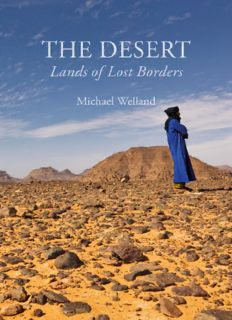
The Desert: Lands of Lost Borders PDF
Preview The Desert: Lands of Lost Borders
t h e d e s e r t THE DESERT Lands of Lost Borders Michael Welland reaktion books For Fotinoula Published by Reaktion Books Ltd 33 Great Sutton Street London ec1v 0dx, uk www.reaktionbooks.co.uk First published 2015 Copyright © Michael Welland 2015 All rights reserved No part of this publication may be reproduced, stored in a retrieval system, or transmitted, in any form or by any means, electronic, mechanical, photocopying, recording or otherwise, without the prior permission of the publishers Printed and bound in China by 1010 Printing International Ltd A catalogue record for this book is available from the British Library isbn 978 1 78023 360 4 Aboriginal and Torres Strait Islander people should be aware that this book contains the words and images of people who have since passed away. Care and discretion should therefore be exercised. Contents Preface 7 one Wet and Dry, Hot and Cold 11 two Big and Small, Fast and Slow 37 three Insiders and Outsiders, Civilization and Savagery 85 four Outsiders and Insiders, New World and Old 130 five Mind and Matter, Body and Soul 178 six Ancient and Modern, Boom and Bust 225 seven Barriers and Corridors, Imports and Exports 281 eight Feast or Famine, Knowns and Unknowns 325 A Personal Epilogue 369 Sources and Further Reading 372 Acknowledgements 390 Photo Acknowledgements and Text Permissions 391 Index 393 Preface Our group had camped in the heart of Egypt’s Western Desert, close to the Libyan border. In fact, we might have actually been in Libya, for, with the exception of the rare, unexpected, sand-blasted and lonely marker post, the border is lost. I am not by nature an instinct - ively gregarious individual and, relishing an opportunity for solitude, I wandered off to climb one of the desiccated and rocky hills that ringed the camp. e desert offers solitude in a way unequalled by any other setting on earth – with the exception of the polar regions, which are, after all, deserts themselves. It takes a while to escape the sounds of one’s companions in the still desert air, but I found a quiet place above a cliff where not only the silence but the view of the landscape was overwhelming. In the crystal light of the desert day, I viewed the landscape through the eyes of a geologist. Details of the multicoloured rock layers in the flanks of flat-topped tablelands and pyramid-shaped hills held stories of times when this now hyper-arid land was covered by seas; changes in the texture and folds of the intervening dune fields told of the wind- blown journeys of the sand, funnelled through gaps in the hills, filling the topography, spontaneously forming inexorably moving dunes. Boulders and rubble on the slopes were witness to the source of the sand, the slow but never-ending erosion of the staunch, but ultimately futile, resistance of the cliffs. It’s a problem that geologists have – an inherent inability to deflect attention from the contents of a scene, whether it’s the setting of a movie, a road cut or a glorious panorama that should be experienced simply for itself. But at night all this inevitably changes and in the desert night dra - m atically so. After dinner, I retraced my steps in the dark to my lookout. But ‘dark’ is not the word. Although it was only a half-moon, I had no 7 the desert need of my head torch and it seemed as if, even without the half-moon, the light from the stars would have been enough. Night in the desert is unique. It reveals and reminds us what the rest of the universe reallylooks like from our humble planet. e Milky Way dazzles. But here I was in the Saharan night, overlooking the same geological landscape that I had enjoyed earlier, but now set out before me in the light of the moon and the galaxies, its colours subdued but still luminous. It was a different place, solitude amplified, silence envelop ing, geology irrelevant. e experience of the desert is, essen- tially, a solitary one, and isolation in the desert night requires taking a measure of oneself. It is no wonder that the great religions, not to mention mystics, ascetics and fanatics, have more often than not emerged from and returned to the desert. A century ago, Mary Hunter Austin was a prolific and eloquent writer on the deserts of the American southwest and an early enthusi- ast for the peoples and environments of the ‘Great American Desert’. In 1909 she published Lost Borders, in the first chapter of which she wrote: Out there, where the borders of conscience break down . . . almost anything might happen; does happen, in fact, though I shall have trouble making you believe it. Out there, where the boundary of soul and sense is as faint as a trail in a sand- storm, I have seen things happen that I did not believe myself. Out there, in the utter silence of that Saharan night, I sat for I don’t know how long and understood intimately what she meant. It suddenly occurred to me that nothing would surprise me there and, despite my non-religious nature, I very clearly and specifically felt that, should God or the Devil – or both – sit down beside me, then this would not be at all strange or shocking. It was, I suppose, the response that Paul Bowles, writing half a century after Austin but echoing her words, termed the ‘baptism of solitude’ that the desert provides. e deserts of the American southwest have provoked a large body of literature and art, to which Mary Austin was one of the first, and rightly celebrated, contributors. Fifty years after her, these lands pro- duced one of the first vociferous environmentalists (some would say ‘eco-terrorists’), Edward Abbey. In his most well-known work, Desert Solitaire, Abbey writes: 8
Description: